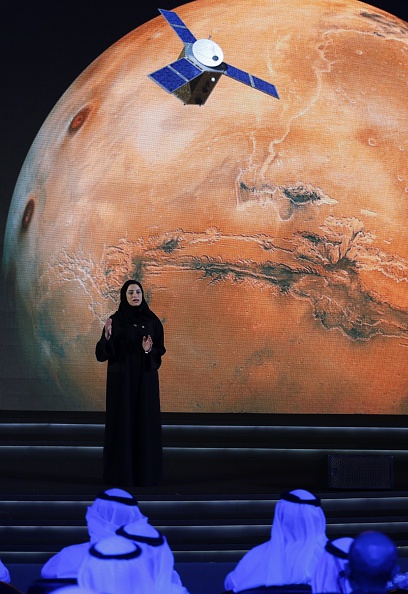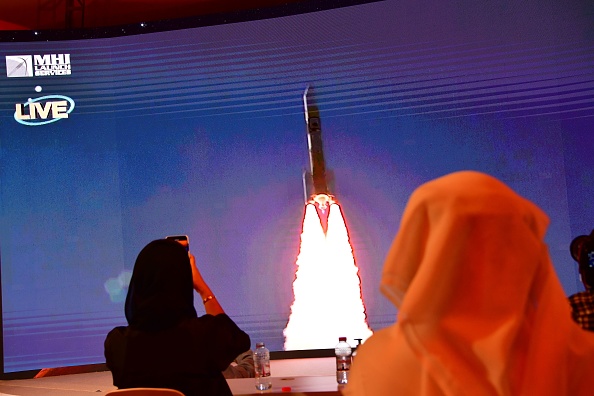33-year old Al Amiri is a Minister of State for Advanced Technology and the Deputy Project Manager and Science Lead of the Emirates Mars Mission. She is responsible for enhancing the contributions of advanced sciences to the development of the UAE. Her Excellency is also the Chairwoman of the Emirates Scientists Council (ESC).
The UAE founded its space agency in 2014, and has set ambitious targets including a colony on the Martian surface by 2117. The "Hope Probe" will be the first probe to provide a complete picture of our planetary neighbour and its layers when it reaches the Martian orbit in February 2021. It will help answer key questions about the global Martian atmosphere and the loss of hydrogen and oxygen gases into space over the span of one Martian year.
The UAE’s mission has been timed to coincide Hope’s arrival into Martian orbit with the nation’s 50th anniversary as an independent country. Through its design and execution, the mission aims to diversify UAE’s economy from traditional activity, including oil and finance. Instead, it wants to inspire a young Arab generation towards scientific and entrepreneurial careers.
HE Sarah Al Amiri was kind enough to take some time out of her day for this interview.
What first inspired you to become interested in space exploration, and how did you enter the field?
I have always been interested in space, but there weren’t any space-related majors when I entered university. Once I graduated, I joined the Emirates Institute for Advance Science and Technology (now known as MBRSC) and this is when I started getting involved in this sector.
What challenges did you face when you entered the government as a young female Minister of State for Advanced Sciences? How did you approach this pioneering role?
The challenges I faced involved the content of our missions and the challenges they posed. The Arab world is a remarkable outlier to the existing gender gap for women in STEM, and even for women in leader positions more generally. We have continuously proven our commitment to diversity and inclusion at the highest levels of government action. Therefore, the focus in my role has always been and will remain building a new generation of Emirati scientists, populated by young women and men, who represent the future and will be prepared and willing to build on the progress we have made so far.
Why is the UAE Mars mission important for the Emirates and the wider region?
This mission represents a future vision for the Emirates and the entire Arab world. Both our country and the region as a whole have young populations, and the goal of the mission is to inspire and to create opportunities for those future generations in the fields of science and technology. Indeed, the region once led the world in science and human understanding, and our hope is that we can do so once again. It is vital that we make this transition to a knowledge-based economy, where The Emirates can be a global hub for technological innovation, attracting talented people from around the world to work together as we prepare for life after oil.
It took your team 6 years to build the Hope Probe. What was the biggest challenge during that period?
Every Mars mission is extraordinarily complex and difficult. What was particularly challenging about the Hope Mission is the tight timeline for development. When the mission was first announced in 2014, the target was set to reach Mars before the UAE’s 50th anniversary in 2021. This meant the team has had to complete the colossal feat of planning, building and preparing the spacecraft for launch in just six years – when conventional Mars missions usual take 10-12 years to develop.
One unexpected challenge on the journey to develop the mission was the Covid-19 pandemic, which threatened to transform what would have been a routine transfer from Dubai to Tanegashima into a very problematic event indeed. A huge logistical effort went into managing the transfer three weeks ahead of schedule and transferring members of the engineering team in order to meet quarantine regulations and still maintain our transfer and launch schedules.

What fascinates you about Mars exploration and why is it important?
The trouble with science is that every time you answer a question, it leads to more questions and that’s never truer than it is with Mars. We have significantly enhanced our understanding of Mars’ climate, geography, its planetary history and its fundamental characteristics, and yet we have more questions jostling to be answered. We know so much, and yet we know so little: how do the incredible planet-encompassing dust storms we have observed happen? What are the atmospheric dynamics of Mars? What is prompting Mars’ atmospheric loss – is it a result of planetary forces and influences or, as we have previously postulated, a product of solar interactions? There are questions around terrain, geology, the Martian magnetosphere, soil composition. There are, literally, millions of questions. We have chosen to provide answers to key questions about Mars’ atmosphere, but I am sure every discovery our data supports will itself lead to more questions.
EMM is driving innovation in The Emirates, building educational capabilities and new opportunities for the nation’s young people to build careers in the fast-growing global space sector and driving excellence in engineering, scientific research and innovation.
From that point of view, the mission is incredibly important – it’s setting the agenda for the development of The Emirates moving forwards. Part of that is driving new investment and innovation in the areas of space engineering and sciences, building a startup and innovation ecosystem around these sectors. Most private sector innovation in space is built on huge public sector investment and long term commitment and we would see our investments into developing space sciences resulting in the development of a thriving private sector, which would indeed produce a capability that would start to explore the exploration and even human settlement of Mars in the long term.
Are we close to putting human feet on Mars?
The success of the Hope Mars mission launch represents an important milestone for the global space community’s aim of landing its first astronaut on Mars. While this target may seem far off, every action at these early stages are crucial in moving towards this goal.
If there were a human mission to Mars launching tomorrow, would you go?
I have the utmost respect for our fearless astronauts who dedicate their lives to relentless training, discipline, and selfless bravery involved in space travel. As a scientist, the dream of going to outer space is undeniable. However, I humbly concede that a seat on such a journey belongs to those who have earned the right to it, through their talent and perseverance. In other words, no. I prefer my feet stuck firmly to the ground!
Climate change, the population explosion, feeding the planet, and recent problems such as the Coronavirus. What can we learn from the Mars Mission and space exploration that could potentially solve these issues?
We believe that improving our understanding of the Martian climate and atmosphere has the potential to helping us better understand Earth’s climate. Furthermore, our ability to be able to better predict and map Mars’ climate will support further research and understanding of a planet toward which there is a widespread aspiration that we will send explorers and possibly even settlers.
What do you hope the impact of the UAE’s interplanetary adventures will be down here on Earth, in a country that has lagged on the research and development front?
Our leadership set an ambitious goal for the mission, in a clear drive to take the team at MBRSC out of our comfort zone and set a challenge beyond the accepted, beyond the ordinary. We had already built a space engineering program that was space capable, through our earth observation satellites, so the intention was a goal that extended our capabilities in leaps rather than steps. The Emirates Mars Mission was, therefore, from the very start intended to be disruptive and to trigger fundamental changes in the development of an advanced innovation ecosystem of The Emirates. In that, I can say with confidence the mission has already succeeded beyond our wildest dreams.

What is the current landscape of gender equality in science, technology and innovation (STI) fields in the UAE and how can we concretely engage girls in science-related fields of studies and careers?
In terms of education, we actually have more women graduating from STEM fields in the UAE than men, so this is not a challenge for us. Our main challenge is the “leaky pipeline” in which there is a very low representation of women in the STEM workforce due to a variety of factors. We are currently in the process of drafting a policy to address this issue.
We celebrated Emirati Women’s Day last week. What are your impressions of the growing achievements of the nation’s women, and what more can be done to support their development and empowerment?
Emirati women have proven that they are more than capable. For example, 80% of the science team in Hope probe consists of women who played a massive role in making this mission work. We also see the spectacular women in leadership positions and their contribution to the development of the country. However, we must work harder to make the workplace women-friendly and to address the obstacles that they have been facing.









